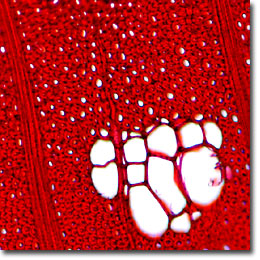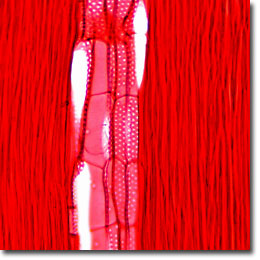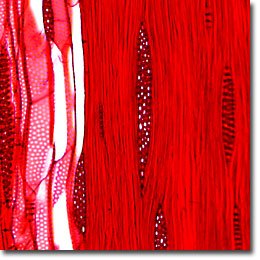The Slippery Elm
The Slippery Elm (Ulmus rubra; also known as the Red Elm) is a hardwood tree found primarily throughout North America, from Quebec to Florida and west to the Dakotas and Texas. Like other elm trees, this tree is susceptible to the Dutch elm disease, a plague that has cost a large number of these beautiful trees. The sapwood ranges in color from grayish white to light brown, while the heartwood is often brown to dark brown with occasional shades of red.

Cross Section

Radial Section

Tangential Section
Similar to other deciduous members of this the Ulmus genus, the slippery elm is an excellent shade tree with numerous branches and a large canopy. Elms are easily transplanted and grow in a wide variety of soils (except very wet or very dry), which has helped combat their extinction by the practically incurable Dutch elm disease. At one time, the susceptible American elm was drastically overplanted and shaded the streets of many New England and Midwestern cities and towns. Over the years, hybridization and selection of resistant elm species has given hope to a recovery for these beautiful trees, but no replacement has ever been found for the spreading, vase-shaped American elm.
In times of famine, early American settlers used the slippery elm as a survival food. It is rumored that George Washington and his troops survived for several days on slippery elm gruel during the bitter winter at Valley Forge. The wood is used for boxes and crates, and other containers required to withstand rough handling, pallets, veneer for fruit, vegetable containers, cheeseboxes, plywood, furniture, upholstery, frames and dinettes, and is a recent favorite for "Danish-type" furniture.
Microscopic examination of iron-alum hematoxylin and safranin stained thin sections (see the digital images presented above) reveals a porous wood with simple perforation plates. Vessels in late wood are numerous, and inter-vessel pits range between 8 and 12 micrometers in diameter and are orbicular or angular (through crowding) in shape. Vascular tracheids are present in both the porous zones and the late-wood vessels. Libriform fibers are medium to thick-walled, frequently gelatinous, and fine to medium in texture. The rays are unstoried, ranging from 1 to 5 seriate and homocellular.